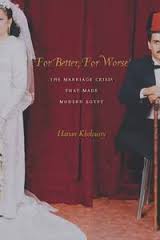|
Reviewed by Iclal Cetin, Associate Professor of Comparative Literature, State University of New York, Fredonia For Better, For Worse offers a thorough examination of the marriage crisis in early twentieth-century (1898-1936) Egypt and is a welcome contribution to gender studies and Middle East studies. As Kholoussy argues in her book, marriage is a quintessential part of Egyptian society, especially in the vast rural portion of Egypt. Therefore, when middle class, Cairene men break from this norm in the 1920s and 1930s, the entire nation including the press, intellectuals, and religious philosophers discourse on this alarming change and engage in heated debates on the subject. Some writers view it as a threat to the nation and others as the adverse effects of modernization. Kholoussy’s focus is certainly not about a single argument or document, neither is it about excavating a single determinant for the marriage crisis. The goal of her fair and insightful study is what the crisis reveals about Egyptian identity in general. By examining recently unearthed early twentieth-century Islamic court records and Egyptian media, Kholoussy discusses how and why marriage became the metaphor for debating the confusion and anxieties over the changing gender roles, power relations, and legal practices in this “semi-colonial” era. The chapters are designed to look at specific discourses surrounding the crisis phenomenon. Chapter two, “Grooming of the Men,” sheds particular light into the financial obligations of the groom within Islamic law, the doctrine of kafa’a, and the consequences of the economic crisis in matters of matrimony. Resonating with the Cairo of Naguib Mahfouz’s Cairo Modern, this chapter offers a dedicated study of the dilemmas and agonies of single, middle class Egyptian men whose commitment to marriage wavers under exorbitant dowries (apparently, an average middle class government employee made LE 8 a month in 1935 and fathers would ask for dowries of LE 400 or 500). Chapters three and four, “The Wedding of Women and Deterring Divorce” and “Modernizing Marriage,” focus on the debates around arranged marriages, the triple divorce oath, the intermingling of sexes, and the alleged increase in divorce rates. Kholoussy’s study offers a particularly novel insight into the inner dynamics of marriage across classes and the fluidity of power relations between husband and wife in Islamic courts. Court documents reveal the negotiations that took place in marriages and the nuances in legal practices (husbands could only demand and receive obedience if they could fulfill their financial duties). One of the most engaging arguments in these chapters is also the nexus between modernization, westernization, and the female body. Chapter five, “Mentoring Mothers, Fettering Fathers,” Kholoussy shows that women became scapegoats in discussions of the marriage crisis in the 1920s. The alleged unfit, inadequate mothering skills of Egyptian women, their backwardness, or their western inclinations, become false-causes in the marriage crisis. Kholoussy’s insightful examination of court documents, however, offers an effective antidote to these arguments. Apparently, some women managed to manipulate the legal system and negotiated their rights and were not in reality passive. In general, Kholoussy’s use of the recently unearthed Islamic court records from the early twentieth century brings a new perspective and offers particular insight into the discourses and practices on marriage, divorce, and gender roles during this transitional period. By integrating interclass marriage, the doctrine of suitability, the triple divorce oath and other Islamic traditions into her analysis of the marriage crisis, Kholoussy shows the differences and discrepancies between lower, middle and upper class marriage and divorce practices, and more importantly, articulates the fine nuances of the Islamic marital traditions. Despite its commendable methodological and historical focus, the book has its shortcomings for advanced scholars in the field of law, Middle East studies, and gender studies, who may look for more depth and detail. The archival research and court documents do not constitute a major part of the text and are mostly exiled to endnotes. The sections on Islamic law are constructed more as overviews for the general public and the chapter on divorce has an oversimplified perspective on the relationship between divorce and gender roles. The author suggests a link between the modern-day and early twentieth century marriage crises, however, there is no developed comparative study or a satisfactory analogy to be found in the book. Lastly, the illustrations constitute a major highlight in this book but are unfortunately, kept to a minimum. |


 For Better, For Worse: The Marriage Crisis That Made Modern Egypt
For Better, For Worse: The Marriage Crisis That Made Modern Egypt